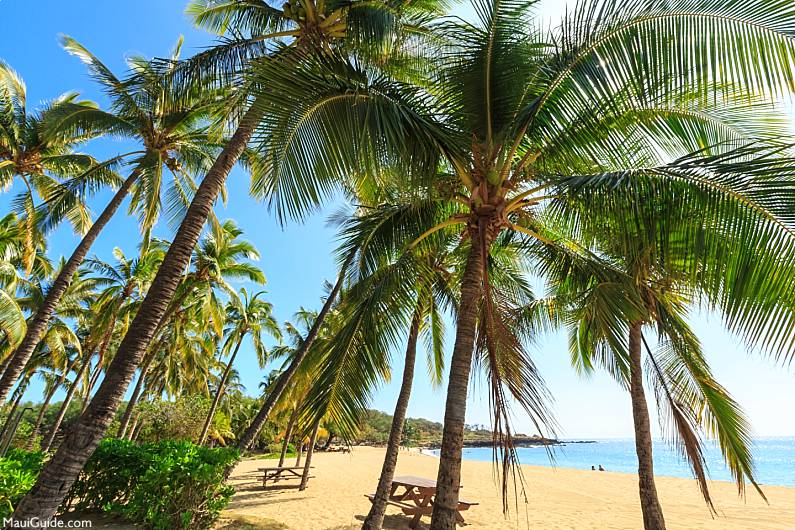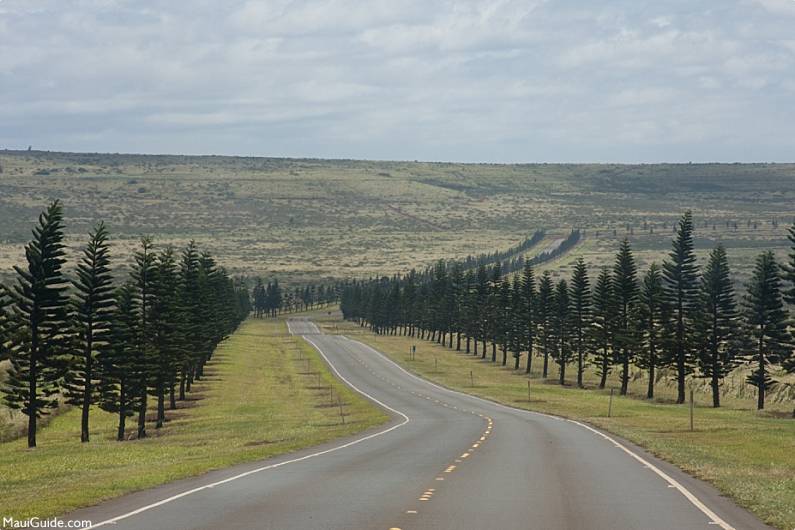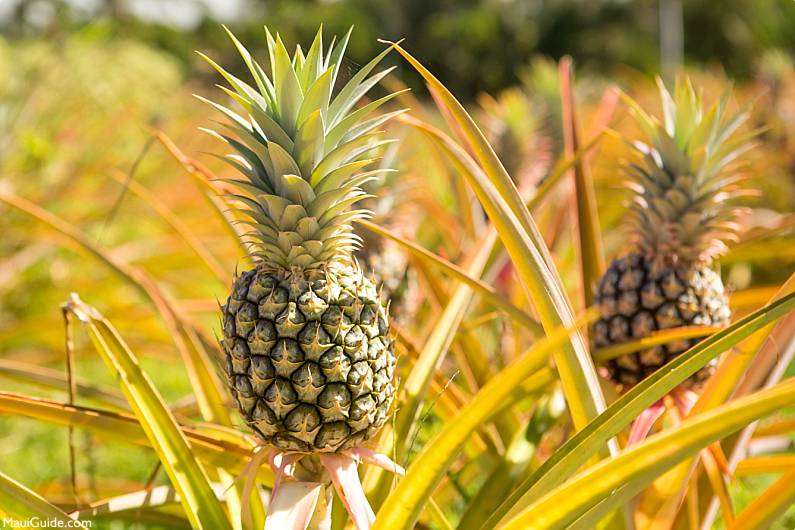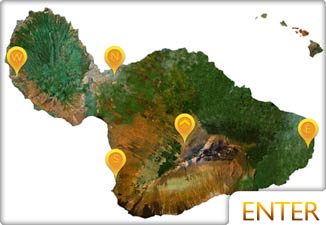Maui > Lanaʻi > History
LANAI HISTORY
Lanai is like no other place in the Hawaiian Islands. Its history is a mix of geology, natural history, and the experiences of people who have lived here for close to 1,000 years. Enjoy this Lanai history article.
See Lanai Map

Lanai History: Manele & Hulopoʻe
Lanaʻi’s Storied Coves & Harbors
Arriving at the coves of Manele (now the small boat harbor) and Hulopoʻe (the neighboring white sand beach) offers seafarers one of the most beautiful natural scenes in Hawaii. Midway between Manele and Hulopoʻe is a small isle or tower of lava. The traditional name of the little islet is Puʻupehe, though for some years it has been called “Sweetheart Rock.” The little bay and northern point around the islet also bear the name Puʻupehe. The surf that rounds the northern point into Hulopoʻe Bay is called Uolokeahi.
Walter M. Gibson, a landowner on Lanai, recorded one native tradition of how Puʻupehe was named in 1868. Reportedly the island is named after a young woman of exceptional beauty who lived in the village of Manele. She tragically drowned in a sea cave during a southerly swell. Pu’upehe’s husband, Makakehau, lamented the passing Puʻupehe and carried her body to the top of the rocky islet. There, he built a platform and buried her. He then cast himself off of the islet in his grief. From that day on the name of this islet and cove have been known as Puʻupehe.

You may walk from Manele harbor to the fine beach of Hulopoʻe (about 1/5th of a mile.) Then a walk of about ½ of a mile along the coastal trail and sea cliffs will take you to the overlook across from Pu’upehe. Looking at Puʻupehe from the sea cliffs you will be able to see the ancient platform and upright stone said to have been built by Makakehau in memory of his beloved Puʻupehe. The platform, at the highest part of the islet, is approximately 6 feet wide by 21 feet long and 3 feet high with an upright stone in its middle.
***To do this walk, you should have covered shoes. Also, you must stay away from the edge of the cliffs, which in some places rise about 200 feet above sea level and are unstable.
Manele Harbor in 1854
In 1854, a group of new settlers chose Lanai as their home. These people came as missionaries of the Mormon Church. A small party from Utah chose the uplands of Palawai, a few miles above Manele landing as the home of the new church. The “City of Joseph” was established in the Valley of Ephraim (Palawai), and native Hawaiians from other islands came to settle on Lanaʻi. In the summer of 1854, Brother Ephraim Green wrote to Brigham Young about the selection of Lanaʻi and the use of Manele as the landing for the new community:
“This morning Br. Hammon left for Maui. I packed my compass and commenced to lay out a town at the foot of the mountain and laid out one street running south to the sea three miles to a fine little harbor where we land our boats. Here we intend to build a shore house to leave our produce. I then laid out three more streets thru the town into blocks four acres each with streets four roads wide. This is a beautiful location for a town.” (Moramona, 1989)
We corrected the old English (or broken English. Not sure what it was.)
The use of Manele as one of three main landings on Lanai continued through 1925, at which time the new harbor of the Hawaiian Plantation Company was built on the western shore of Kaumalapaʻu.

In July of 1862, Walter Murray Gibson, then head of the Mormon settlement at Palawai, wrote to King Kamehameha IV asking for support of the Lanai colony. In speaking of Manele, he wrote:
“We would if in possession of the land make a good wagon road to the coast. We would also construct wells, and substantial cisterns; or even reservoirs for purpose of irrigation. We have constructed some small cisterns for domestic use. Furthermore, we would construct a slip at the roadstead of Manele suitable for the safe mooring of one or more coasting craft…”
Lana’i Mele
In the 1870s, the descendants of Kanekeleia and Lululipolani, traditional residents of Manele, shared a mele (chant) in honor of their daughter, in which they described noted places around Manele. Some of the excerpts from their mele, such as localities, resources, and names, can still be seen today. It has been translated below:
This is for you Kamakaehukai,
The woman who is Lanaʻi,
From the sands of Manele,
From the Murmuring sea, where nothing is found to criticize,
Sweetly murmuring in the still of the night…
Companion who swims in the sea
Friend of the waves of the ocean,
Of the surging sea,
The waves of Naehehe Channel…
Aloha to you – the glistening sands of Kaupakuea,
The diving spot of Leinohaunui,
Puʻupehe which swims there in the sea,
The surf of Uolokeahi,
The sands of Hulopoʻe,
And the sea of Kaluakoi…
A short walk from Manele Harbor to Hulopoʻe Beach and along the coast will reveal the natural wonders that make this leeward shore of Lanaʻi unique.
NEW: Kapalua Guide
Manele Harbor
The Roadstead (harbor) of Manele was established, and throughout much of the 1800s, served as a regular stopping point for interisland steamers. In 1873, Walter M. Gibson penned an article in Nu Hou, a local newspaper, telling readers of a voyage to Lana’i and landing at Manele. He described their journey on horseback up to the Palawai Basin. The following is an excerpt from Nu Hou:
“We were on board the staunch old steamer Kilauea, now in fine trim, running along by the lee shore of Lanai. The strong current here and the bold rocky shore call for a careful lookout: and they get it from the faithful McGregor, who keeps watch and ward all the night long, a tireless sentinel on the bridge of the steamer who will trust to no other but his own well weather-beaten eyes, so long as darkness and danger are abroad.
The Shrill whistle at about four in the morning waked the echoes among the lofty bluffs that form the heads of the bay of Manele on the southeastern end of the island. A pull of ten minutes brought us inside our breakwater, and here being free from the break of surf, we landed all safe and dry at our very boathouse door. Loving eyes had watched for us, and we found fat Lanai horses ready to bear us in the cool grey of the morning up the hills into the mountain valley of Palawai. It looked lovely as when it first won our hearts. The terraced and shrub adorned hills set back like a throne for a heavenly majesty, and the canopy of cloud softened the glory which the god of day shed in damning splendors over the scene of flowered vale, and green wooded ravines and hills…” (April 8th, 1073, Nu Hou Newspaper)
Manele Landing 1921
It was not until around 1920 that the first experiments in planting pineapple on Lanai were undertaken. At the time, the island was, in part, owned by the Charles Gay Family. In the uplands of Lanai, behind Lana’i City, the first pineapple crops were planted. When the fruit was harvested, they were taken in trucks down to Manele Landing via a stone and dirt trail that was almost impassable. The crop was then loaded on small boats and transferred to Maui for canning. It was a difficult trip, which caused the loss of much of the fruit due to bruising. But, as a result of the Gay Family’s success, James Dole’s Hawaiian Pineapple Company knew that the crop could be grown, and in 1922, Dole purchased almost the entire island of Lanaʻi.

Since then, the Pineapple isle has suffered due to cheaper pineapples being grown and distributed from Central and South America. The high cost of shipping the fruit, as well as the cost of labor in Hawaii, contributed to the closing of the pineapple company. Now Lanai is primarily known for small farming, a Four Seasons Resort, and potentially for a large wind farm project.
Manele Beach Resort
Manele used to be the beach resort for employees of the Hawaiian Pineapple Company.
A 1939 article in the Maui News reported on developments on Lanai, and it provided readers with the following description of Manele:
“Hawaii has few if any better spots for swimming and fishing than Lanai’s Manele Beach. Six miles distant from Lanai city, Manele offers an easily accessible playground for Hawaiian Pine’s employees on the Pineapple Isle. Several beach houses are maintained there where employees can spend on outings. Ample facilities in addition to Manele Beach are maintained on Lanai for Employees…” (Maui News – Lanai Section, October 11, 1939)

By the mid-1960s, the state of Hawaii undertook the upgrading of Manele Bay to provide shelter for local fishing boats and visiting craft. With the advent of the harbor improvements came the loss of the old sandy beach and canoe landing of Manele and Kaupakuea Village. Today, the new State Harbor facilities at Manele (officially dedicated on August 20th, 2008) make this the finest small boat harbor in all of Hawaii. Today, the various bays around Lana’i are visited more frequently for the great snorkeling opportunities.
Hoʻau Pipi
On rough days, when the steamers couldn’t safely draw along the Manele cliff side, cattle were driven into the ocean at Hulopo’e Beach. They were then tied up to a launch, which took them out to the steamer and hoisted onto the boat for transport. Typically, anywhere from 30-70 cattle from Lanai were shipped in one trip.
The Pipi (Cattle) Chute of Manele
Throughout the 1800s and the early 1900s, ranching was the primary commercial enterprise on Lanaʻi. Initially, activities focused on goats and sheep, but around 1910, cattle became the primary stock. To ship the cattle (in Hawaiian, pipi) to Honolulu, the animals were driven down to Manele, held in pens, and then loaded on interisland steamers. Initially, the cattle were driven into the water and dragged out to the waiting steamer for loading.
Around 1920, a chute was built on the Leinohaunui Cliffs, on the south side of Manele Bay. With the construction of the chute, the pipi could be driven along the cliffs to the chute and walked across the water onto the waiting boat. The “Pipi Chute” and a series of mortar saltpans were built on the cliffs as a part of the ranch operations. The saltpans were periodically filled with saltwater, which evaporated and provided fresh sea salt for drying meat and treating hides.

The information and photos above have been taken from the information boards at Manele Harbor in order to further the learning of our visitors. Mahalo for reading and we look forward to seeing you on Lana’i soon! ALOHA!



